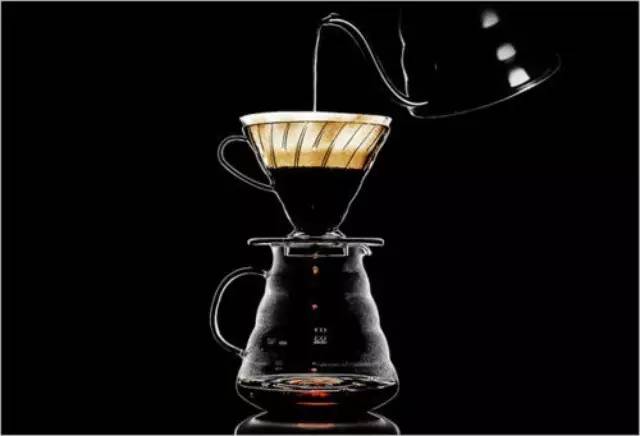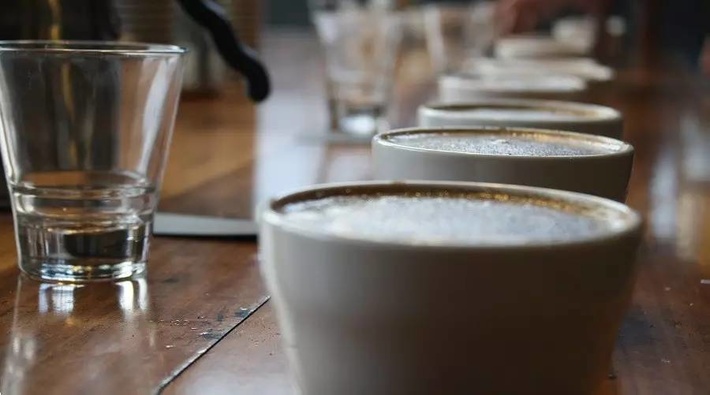Coffee brewing method: the basis of coffee-detailed introduction of the operation process of siphon pot

The basis of coffee-the operation process of siphon pot

Beakers, flasks, alcohol lamps, which are generally believed to belong to chemical experiments, are used to make coffee, which is the unique way of siphon coffee brewing.
Siphon pot (Syphon), commonly known as "glass ball" or "siphon type" and "plug style", is a simple and easy-to-use method of coffee brewing, easy to operate and excellent for viewing, and it is also one of the most popular coffee brewing methods in cafes. Siphon coffee originated from Europe and the United States, but it is popular in Asia. Its meticulous production method and pure and bright production style make it very popular in Japan and Taiwan.

Although it is called a siphon kettle, it has nothing to do with the siphon principle, but uses water heating to produce water vapor, causing thermal expansion and cold contraction, pushing the hot water from the lower sphere to the upper pot, and then sucking back the water from the upper pot after the lower pot cools. Does that sound mysterious? Not at all. Follow the following steps and you will understand!
Siphon brewing method, the use of air pressure to make the right temperature of hot water in contact with coffee to extract coffee. Watching the water in the beaker rise slowly as it is heated to boiling, extract enough coffee and then slowly drop as the beaker cools, and a full-bodied cup of coffee is finished. Every step of the change is in your own hands, making you feel as if you are in a precise and meticulous chemical experiment, and excellent visual enjoyment also makes more people fall in love with siphon coffee.

[siphon Coffee | making steps]
1. After boiling the filter in hot water for 5 minutes, put it into the upper pot. The chain of the filter is pulled down through the wall of the upper pot to hang the hook and fine-tune to keep the filter in the center of the upper pot. Fill the pot with hot water to "two cups". Put the filter element into the pot, hold the end of the chain with your hand, and gently hook it to the end of the glass tube. Be careful not to release the hook suddenly, so as not to damage the glass tube of the upper pot.

two。 Pay attention to wipe the water droplets at the bottom of the bottle before heating to avoid damage to the utensils. Light the alcohol lamp and insert the upper pot obliquely so that the rubber edge is pressed against the spout of the next pot (rest assured that the upper pot will not fall off) so that the chain is soaked in the water. Then boil the water and wait for the pot to produce continuous bubbles. Just put the upper pot diagonally, don't let it clog the next pot, small bubbles don't count, wait for big bubbles to appear.

3. When large bubbles appear continuously in the lower pot, straighten the upper pot, shake it left and right and press it down slightly so that it is gently stuffed into the lower pot. After the upper pot is plugged in, you can see that the water in the next pot begins to climb up. If you have a bean grinder, you can start grinding beans now! Two cups of water use a medium grinding scale of three spoonfuls of coffee (about 24g)

4. After the water has completely risen to the pot, don't worry, wait a few seconds, and then prepare to pour in the coffee powder after the bubbles in the pot decrease a little. Pour in the ground coffee powder and move it around with a bamboo spoon to evenly remove the coffee powder into the water. The timing starts at the same time as the first stirring.
Stir gently to avoid violent stirring. If it is fresh coffee powder, it will float on the surface to form a layer of powder. At this time, the coffee powder needs to be stirred so that the flavor of the coffee can be completely extracted. The correct stirring action is to move the bamboo spoon in the left and right direction, with a "strong way" of downward pressure, to "press" the coffee powder floating on the surface of the water below the surface. When the water in the lower pot reaches about 88 degrees, start inserting it into the upper pot. Note that the siphon tube should be perpendicular to the fire source in a straight line. When hot water flows upstream into the pot and mixes with coffee powder, quickly stir 6-8 times with a bamboo knife and be careful not to touch the filter. After the mixing is finished, start the clock, about 1 minute.

5. By observing the state of the foam layer, the stirring, firepower and extraction time can be adjusted. When using the correct brewing method to brew fresh coffee powder, the upper part of the coffee liquid produces rich and delicate bubbles, accounting for 1 big 3 or 1 big 4 of the coffee liquid. After the extraction is complete, turn off the alcohol lamp and stir for another 6 or 8 times before the coffee liquid drips. After the first stirring, time 30 seconds, make the second stirring, and then time 20 seconds for the final stirring-- the alcohol lamp can be removed. Take the pre-prepared (wrung-dry) slightly wet dishcloth and gently wrap the side of the lower pot from the side to prevent the wet cloth from touching the place where the alcohol flame at the bottom of the pot comes into contact, so as to prevent the pot from breaking. At this time, you can see that the water in the upper pot is quickly "pulled" to the lower pot. If your coffee is fresh enough, there will be a lot of light brown foam in the pot.

6. When the air is completely countercurrent and the coffee liquid drips completely into the lower pot, the filtration is complete.

7. After the coffee is sucked into the lower pot, hold the upper pot in one hand and the handle of the lower pot in the other, gently shake the upper pot to the left and right to pull out the upper pot and the lower pot. Pour the coffee into a warm coffee cup and enjoy the mellow coffee that you have prepared by hand. Press the joint and tilt to take out the pot, pour the coffee into the coffee cup, and finish.

Siphon coffee pot is most common in Taiwan and Japan. It is said that it was first invented by Scottish shipbuilder Robed Napier, and also appeared in Germany in 1830. Finally, it was continuously improved by France and Britain to become the top and bottom of the coffee pot. Under the action of heating and atmospheric pressure, the coffee pot makes the water go up (the air rises), and after the heat is turned off, the coffee is filtered down (the cold air drops) to complete the soaking and filtering of the coffee pot. It tastes so elegant that the producer seems to be a researcher.

Due to the use of high temperature extraction, the siphon kettle is easy to produce aroma, and the alcohol thickness is relatively high, but the taste is not as good as the level change of drip filtration. Plus coffee powder soaked in hot water. Therefore, it is not easy to show subtle taste differences. But the siphon pot is quite suitable for performance and display, so it may be just suitable for the promotion of boutique coffee, basically only suitable for players to perform, I think it is still a bit troublesome to use at home. At present, the most popular coffee in the United States and other places is the siphon pot of coffee heated by halogen lamps.
Siphon pots have become a thing of the past in Japan and can hardly be seen recently. The degree of grinding of coffee powder is the same as that of manual drip filtration. The baking degree is medium baking ~ medium depth baking. Siphon pot is a relatively stylized extraction method. Stirring at which time and leaving the fire at which time is the key. In addition, in order to avoid the temperature drop in the extraction process and accidentally cook miscellaneous smell, the firepower must be adjusted appropriately. The adjustable range is narrow, and the household is not as convenient as manual flushing.

Source: Aiwo fragrant coffee
Important Notice :
前街咖啡 FrontStreet Coffee has moved to new addredd:
FrontStreet Coffee Address: 315,Donghua East Road,GuangZhou
Tel:020 38364473
- Prev

Coffee brewing method: do not fail hand-brewed coffee guide [step diagram] Classic text
When it comes to coffee beans, they can be divided into light roasting, medium roasting and heavy roasting. Coffee cherries are actually like fruits. Good coffee beans have fruity, floral, cocoa, nutty flavors, etc., usually the lighter the roast and the more sour they are, the more they can drink the essence of the coffee beans; on the contrary, the heavier the roast, the more bitter. As far as brewing is concerned, different brewing methods, different extraction methods and time should not be given.
- Next

Coffee technology; detailed introduction to the use of SCAA cup meter
Coffee cup meter in recent years, the coffee roasting market continues to heat up, the international trade of raw beans is becoming more and more frequent, and the market of coffee beans is gradually opening. fine coffee in the industry, self-baking / fresh quality, selection / selection, private customization / generation inheritance, blending folk prescription. The tide of coffee entrepreneurship is unprecedented, the discussion of roasting skills is handed down from generation to generation, and the learning of cup testing is scraped and quenched.
Related
- What is the meaning of lactic acid fermentation with coffee bean treatment?
- How to judge the state of foam by sound?
- How does the latte pull out the unicorn pattern? Come to get for a little trick to improve the flower pull!
- Will flower pulling affect the taste of the latte?
- Do you know the history of coffee?
- The difference between honey treatment and sun washing what is raisin honey treatment?
- What kind of milk can a novice use to make coffee foam to keep the foam longer? The correct method and skills of milking tutorial sharing
- Why do washed coffee beans taste sour? Flavor characteristics of washed Coffee
- Introduction to the skill of how to practice the size and height of water injection around the circle of hand-brewed coffee
- How do beginners practice coffee flower drawing from scratch?

